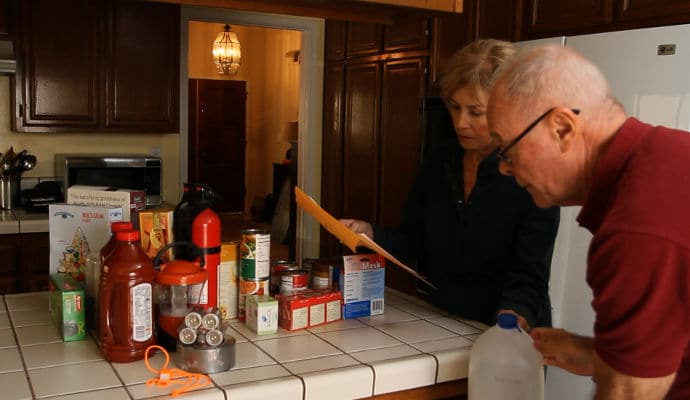
Seniors are especially vulnerable during natural disasters
Emergency preparedness tips for older adults increase their safety during a natural disaster. Seniors who need care are especially vulnerable during an emergency because they can’t easily get around and often have special healthcare needs.
Creating an emergency kit and plan takes some effort, but it can mean the difference between developing a serious health issue or surviving the disaster unharmed.
We share 4 important steps you can use to help your older adult prepare for the next natural disaster.
4 essential emergency preparedness tips for older adults
1. Build an emergency kit
It’s critical that your older adult has the food, water, medicine, and supplies they’ll need to survive an extended power or water outage.
Prepare 7 days (a week) of basics like:
- Clean drinking water – one gallon per person per day
- Non-refrigerated or non-perishable foods they can easily eat
- All necessary medications and medication supplies like syringes for insulin
- Garbage bags and plastic ties for temporary toileting
- Moist towelettes for personal hygiene
- Flashlights and batteries
- Radio for news and alerts (battery powered)
- Wrench or pliers to turn off gas or water
- First aid kit
- Whistle
- Dust mask
- Plastic sheeting and duct tape to shelter in place
Keep copies of important information like:
- A list of prescriptions, over-the-counter medications, and orders for medical equipment – including dosage, treatment, and allergy information
- Medical insurance and Medicare or Medicaid cards
- Contact information for doctors, family, friends, hired caregivers, and other people in their support network
Add special supplies like:
- Extra batteries for devices like hearing aids or wheelchairs
- An extra pair of eyeglasses
- Catheters, feeding tube, or ostomy supplies, etc.
- Plan ahead for refrigerated medications like insulin for diabetes – talk with the pharmacist or doctor about emergency options
- Oxygen – contact the power company to alert them of this special power need and ask the medical equipment company about emergency options (more info here)
- Extra food and water for pets or service animals
2. Form a support network
You might not always be nearby to help your older adult when disaster strikes. That’s why it’s essential to create a support network of trusted neighbors, relatives, and friends who could step in during an emergency.
Familiarize them with your older adult’s needs. Make sure everyone knows which medications, supplies, and medical devices are important, where they’re kept, and how to use them. Also, give them a copy of the emergency plan and access to your senior’s residence.
Depending on the type of disaster, it could be safer to either evacuate or shelter in place. Nature is unpredictable, so prepare one plan for sheltering in place and another for evacuating.
Written plans are best for handing out and reviewing with everyone in your senior’s support network. That way everyone will be clear on what to do and where to go. And if you’re separated, you’ll know where to find your older adult.
If they need routine treatments in a clinic or hospital (like dialysis), talk to the service provider about what to do and where to go for back-up care during an emergency. Be sure to include that information in the emergency plan.
4. Make sure federal benefits payments are accessible and secure
Seniors who depend on Social Security or other federal benefits can run into trouble if they rely on mailed payments.
During emergencies or evacuations, mail services can be interrupted for days or weeks. Even worse, checks could get stolen. To prevent financial problems and fraud, make sure your older adult is receiving their benefits electronically.
Important: Seniors who are still getting a paper check for Social Security or other federal benefit payments are out of compliance with the law.
How to switch to electronic benefits payments:
- Choose to get payments either by direct deposit to a bank or credit union account or to a Direct Express® prepaid debit card account. If your older adult has a bank account, direct deposit is the best option.
- Sign up for direct deposit to a bank account by contacting the U.S. Treasury Electronic Payment Solution Center at (800) 333-1795, signing up for direct deposit online (select the direct deposit option), or signing up through your local bank or credit union.
- Sign up for the Direct Express® card by contacting the U.S. Treasury Electronic Payment Solution Center at (800) 333-1795.
Next Step See FEMA’s emergency preparedness tips for older adults
Recommended for you:
- How to Evaluate Emergency Preparedness in Assisted Living: Questions to Ask
- Why Seniors Need Extra Medicine for Emergencies
- Dehydration in Elderly Is a Serious Health Risk
By DailyCaring Editorial Team
Source: Ready.gov
Image: Urban Survival Times
[optin-monster slug=”yxbytm35zhsdfopnw7qk”][optin-monster slug=”jvhyplxmb4umsjazxecn”]
About the Author

Connie Chow
Connie was a hands-on caregiver for her grandmother for 20 years. (Grandma made it to 101 years old!) She knows how challenging, overwhelming, and all-consuming caring for an older adult can be. She also knows how important support is — especially in the form of practical solutions, valuable resources, and self-care tips.





Write down all your computer login names and login passwords so, if you are in an emergency evacuation shelter, you can access your email, insurance agent, bank, and doctors. Put a copy in your emergency kit. Put a copy in your safe deposit box. Put a copy in a sealed envelope and give it to your lawyer to keep with your will and trust documents. It’s also a good idea to give a copy to your kids who live out of the area. Update at least twice a year.
Excellent advice! Thank you for sharing.